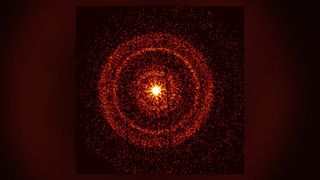The James Webb Space Telescope has discovered the cause of the most powerful cosmic explosion since the Big Bang.
The explosion (nicknamed the BOAT or "brightest of all time") is a gamma-ray burst (GRB) that spat photons at Earth with more energy than those found inside the Large Hadron Collider. This light was detected by telescopes in orbit and on the ground on October 9, 2022, and came from 2.4 billion light-years away in the constellation Sagitta.
Now, a team of scientists have tracked down BOAT's likely origins to a gigantic supernova that came after the collapse of a giant star.
Yet their research reveals a new mystery — supernovas such as the one behind the BOAT are supposed to be cosmic factories for heavy elements such as platinum and gold, but when the researchers looked, they found no evidence for them. The scientists published their findings April 12 in the journal Nature Astronomy.
"When we confirmed that the GRB was generated by the collapse of a massive star, that gave us the opportunity to test a hypothesis for how some of the heaviest elements in the universe are formed," lead study author Peter Blanchard, an astrophysicist at Northwestern University, said in a statement. "We did not see signatures of these heavy elements, suggesting that extremely energetic GRBs like the BOAT do not produce these elements.
“That doesn't mean that all GRBs do not produce them,” Blanchard added, “but it's a key piece of information as we continue to understand where these heavy elements come from."
When a massive star runs out of fuel, it collapses before exploding outward in a gigantic supernova explosion, leaving behind an ultra-dense neutron star or a black hole. It is these stellar explosions — and occasionally even collisions between two neutron stars — that produce powerful bursts of gamma rays that can be picked up by observatories in space and even on Earth.

The first gamma-ray bursts were detected accidentally by US military satellites in the 1960s. Since then, they have continued to ping up on equipment that is able to detect their high-energy light. But when the BOAT appeared, it was at least 10 times brighter than any other cosmic explosion ever witnessed.
"The event produced some of the highest-energy photons ever recorded by satellites designed to detect gamma rays," Blanchard said. "This was an event that Earth sees only once every 10,000 years.”
The burst was so bright, in fact, that the astronomers had to wait six months for it to die down before they could use the James Webb Space Telescope to look at it directly.
"The GRB was so bright that it obscured any potential supernova signature in the first weeks and months after the burst," Blanchard said. "At these times, the so-called afterglow of the GRB was like the headlights of a car coming straight at you, preventing you from seeing the car itself. So, we had to wait for it to fade significantly to give us a chance of seeing the supernova."
After pointing the JWST's Near Infrared Spectrograph (NIRSpec) instrument towards the source of the explosion, the researchers found signatures of elements such as oxygen and calcium, which are commonly found within supernovas. But they didn't find any elements heavier than iron among the debris, potentially ruling out bright explosions such as the BOAT as heavy metal producers.
And surprisingly, despite the extreme brightness of the gamma-ray burst, the supernova it came from was of fairly average brightness. It's possible, according to the researchers, that the BOAT acquired its extraordinary intensity from the exploding star's material being funneled along an unusually narrow relativistic jet — a near-light-speed stream of charged matter.
"It's like focusing a flashlight's beam into a narrow column, as opposed to a broad beam that washes across a whole wall," co-author Tanmoy Laskar, an assistant professor of physics at the University of Utah, said in the statement. "In fact, this was one of the narrowest jets seen for a gamma-ray burst so far, which gives us a hint as to why the afterglow appeared as bright as it did. There may be other factors responsible as well, a question that researchers will be studying for years to come."
The researchers say their next steps will be to use the JWST to look at other supernovas. Contrasting their different brightnesses, jets, chemical elements and host galaxy characteristics could help them figure out just how unusual the BOAT was, and the conditions under which the universe's heavy elements are made.
https://news.google.com/rss/articles/CBMilQFodHRwczovL3d3dy5saXZlc2NpZW5jZS5jb20vc3BhY2UvamFtZXMtd2ViYi10ZWxlc2NvcGUtZmluZHMtb3JpZ2lucy1vZi10aGUtYmlnZ2VzdC1leHBsb3Npb24tc2luY2UtdGhlLWJpZy1iYW5nLXJldmVhbGluZy1hLW5ldy1jb3Ntb2xvZ2ljYWwtbXlzdGVyedIBAA?oc=5
2024-04-12 09:00:00Z
CBMilQFodHRwczovL3d3dy5saXZlc2NpZW5jZS5jb20vc3BhY2UvamFtZXMtd2ViYi10ZWxlc2NvcGUtZmluZHMtb3JpZ2lucy1vZi10aGUtYmlnZ2VzdC1leHBsb3Npb24tc2luY2UtdGhlLWJpZy1iYW5nLXJldmVhbGluZy1hLW5ldy1jb3Ntb2xvZ2ljYWwtbXlzdGVyedIBAA
Tidak ada komentar:
Posting Komentar